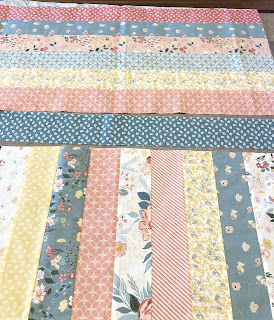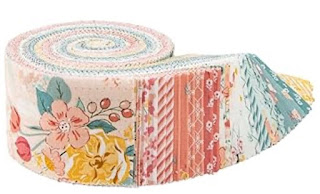This is a fairly simple strip quilt, however, the instructions seemed a little wordy so we decided to do them on the blog where we can post some photos as we go along. Here goes--
Use an accurate ¼ seam throughout this project.
Pull the Teal strips with the little white posies from the jelly roll and set aside. (We have cut and extra strip of this print for your kit so you should have 3 strips.) These strips will form the cross pieces through the quilt.)
Sew strips together along the length to create the following sets:
One set of 15 strips
One set of 8 strips
Two sets of 7 strips. This should leave one strip from the Jelly Roll which will be used later.
Press the strip sets.
Trim the selvedge from both ends of the set of 15 strips making sure the unit measures 42 inches long.
Measure the width of the 15-strip set (should be 30 ½ inches). Cut a 30 ½ inch piece (or whatever yours measured) from the 8-strip section.
Cut the same length from one of the teal strips. Sew the teal strip to the top of the 15-strip section.
Sew the 8-strip unit to the top of this. (The 15 strips will be oriented vertically and the other section will be oriented horizontally.
Cut a 16 ½ inch section from one of the 7-strip units. Cut two 16 ½ inch lengths from the remaining 2 ½ inch jelly roll strip (not the teal strips). Sew one to each side of the 16 ½ inch piece, matching the direction of the strips.
Sew an 18 ½ inch teal strip across the bottom of the section. (The strips should be oriented vertically with the teal strip oriented horizontally across the bottom.)
From the remaining 7-strip pieces cut three 18 ½ inch sections. Sew these together with the strips oriented horizontally.
Sew this section to the bottom of the section 16 ½ x 18 ½ inch section created above.
Join teal strips to create a strip the length of the quilt (should be about 58 ½ inches.) Sew the two sections of the quilt together with the teal strip between making sure the teal strips match up correctly at their intersection.
Applique the flower on the intersection of the teal strips if desired. (We pieced leftover prints to create the center of the flower.)
Quilt as desired. Bind and enjoy!
We will be using fabric from the "Stay Wild" line for Riley Blake Designs for the July mystery quilt.
Sign up now! Call 801-465-9133.











.jpg)

